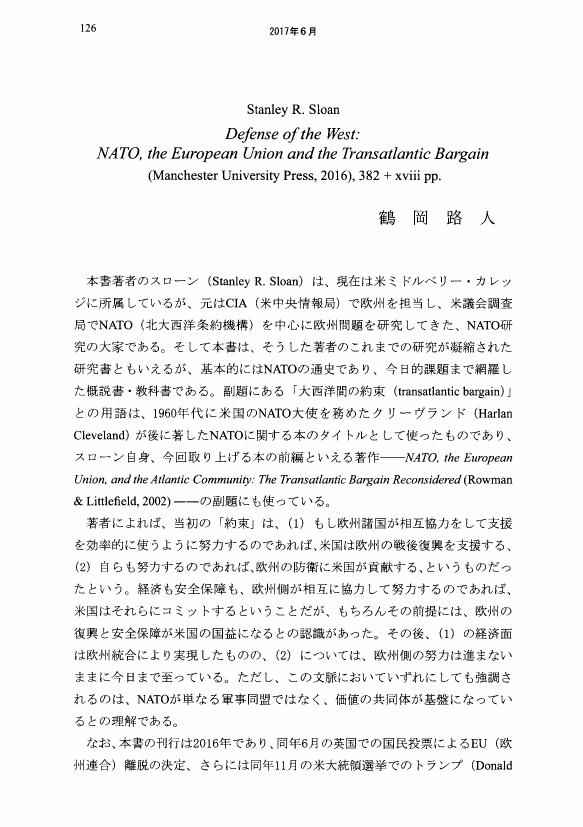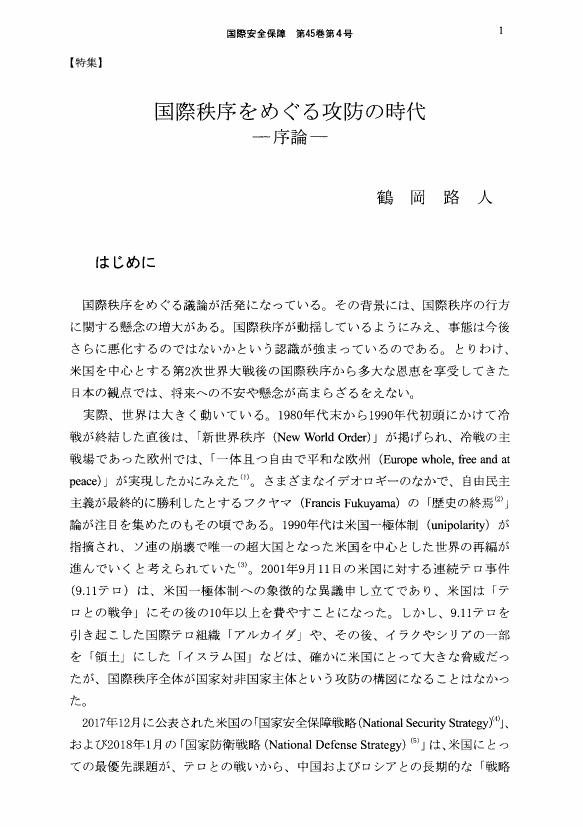49 0 0 0 OA NATOにおける集団防衛を巡る今日的課題 ―ロシア・グルジア紛争と北大西洋条約第5条の信頼性―
- 著者
- 鶴岡 路人
- 出版者
- 国際安全保障学会
- 雑誌
- 国際安全保障 (ISSN:13467573)
- 巻号頁・発行日
- vol.37, no.4, pp.88-106, 2010-03-31 (Released:2022-04-14)
43 0 0 0 統一ドイツのNATO帰属への道--冷戦と冷戦後の狭間
- 著者
- 鶴岡 路人
- 出版者
- 慶応義塾大学大学院法学研究科内「法学政治学論究」編集委員会
- 雑誌
- 法学政治学論究 (ISSN:0916278X)
- 巻号頁・発行日
- no.51, pp.559-593, 2001
23 0 0 0 OA 欧州における同盟、集団防衛、集団的自衛権 ――新たな脅威へのNATO、EUによる対応――
- 著者
- 鶴岡 路人
- 出版者
- 国際安全保障学会
- 雑誌
- 国際安全保障 (ISSN:13467573)
- 巻号頁・発行日
- vol.44, no.1, pp.64-82, 2016-06-30 (Released:2022-04-01)
21 0 0 0 OA ヨーロッパ通貨統合への道 EMUへの政治的コミットメントの形成過程, 1988-1989年
- 著者
- 鶴岡 路人
- 出版者
- 日本EU学会
- 雑誌
- 日本EU学会年報 (ISSN:18843123)
- 巻号頁・発行日
- vol.2002, no.22, pp.283-312,373, 2002-09-30 (Released:2010-05-21)
In January 1999, the biggest project in the history of European integration, the Economic and Monetary Union (EMU), was realized and a dream of having a single European currency finally came true. The achievement of it was neither foreordained nor just a logical consequence of market integration in the EC. It was rather a project highly political in nature.This article tries to explain the significant initial phases of the political process to create a European single currency from the early 1988 to the end of 1989. In January and February 1988, some proposals for a monetary union in the EC were aired by the French, Italian, and German ministers, which were, however, rather vague in content and proposed mainly as political balloons at the time. But two years later in Strasbourg in December 1989, the leaders of the European Communities came to the agreement to convene an Intergovernmental Conference (IGC) to draw a new treaty on EMU, which was to begin its work by the end of 1990. Why and in what ways was such a great leap from just a vague balloon to the concrete agreement to revise a treaty made possible during this relatively brief period of less than two years? What has changed the nature of the EMU discussions?The main line of argument is as follows. When some calls for EMU notably the Balladur Memorandum were tabled and the discussions on its possibility became lively in the early 1988, there was no political commitment to the realization of EMU at all. Though the subsequent decision in Hanover in June that year to create a so-called Delors Committee on the study of EMU, and the approval of the Committee's report at the Madrid European Council meeting in June 1989 were of course significant steps forward, they by no means determined or ensured the way to the single currency. In fact, the Madrid summit failed to set a date to convene the IGC to make a new treaty on EMU. We had to wait six more months to have a concrete political commitment to EMU from Paris and Bonn, the two most significant actors on this issue. And the decision at the Strasbourg European Council in December 1989 to start an IGC by the end of 1990 made the road to EMU irreversible. Leading up to the Strasbourg agreement, the ever-accelerating upheavals in the Communist countries in the East, the eventual fall of the Berlin Wall on November 9, and the ensuing acceleration of the issue of German unification all played the significant role of stimulating the emergence of the political commitment to EMU.The situation under which the issue of EMU was discussed thus went through a radical change, which inevitably influenced the positions and perceptions of the actors. As the political commitment particularly by France and West Germany emerged in the fall of 1989, the road to EMU became irreversible, which was a great leap from the situation of two years earlier.
9 0 0 0 OA Stanley R. Sloan, Defense of the West: NATO, the European Union and the Transatlantic Bargain
- 著者
- 鶴岡 路人
- 出版者
- 国際安全保障学会
- 雑誌
- 国際安全保障 (ISSN:13467573)
- 巻号頁・発行日
- vol.45, no.1, pp.126-130, 2017-06-30 (Released:2022-04-01)
3 0 0 0 OA 欧州戦術核問題の構図
- 著者
- 鶴岡 路人
- 出版者
- 国際安全保障学会
- 雑誌
- 国際安全保障 (ISSN:13467573)
- 巻号頁・発行日
- vol.40, no.4, pp.1-18, 2013-03-31 (Released:2022-04-07)
1 0 0 0 OA 国際秩序をめぐる攻防の時代 ―序論―
- 著者
- 鶴岡 路人
- 出版者
- 国際安全保障学会
- 雑誌
- 国際安全保障 (ISSN:13467573)
- 巻号頁・発行日
- vol.45, no.4, pp.1-12, 2018-03-31 (Released:2022-04-01)
1 0 0 0 OA NATO変革の中の災害救援 ―パキスタン地震救援活動と同盟変革の方向性―
- 著者
- 鶴岡 路人
- 出版者
- 国際安全保障学会
- 雑誌
- 国際安全保障 (ISSN:13467573)
- 巻号頁・発行日
- vol.34, no.3, pp.93-117, 2006-12-31 (Released:2022-04-20)





